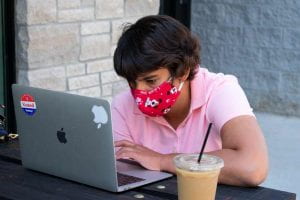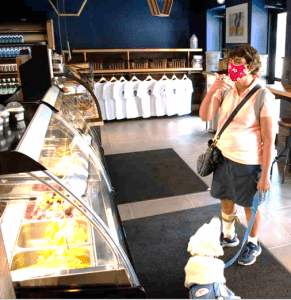Guest Post: It’s National Disability Employment Awareness Month, so this month, Shared Solutions welcomes blogger Adria Nassim. Folks in Bloomington, Indiana, know Adria as a passionate voice for change in the community. She writes a regular column for the Herald Times and shares her love of dogs with her service companion, Lucy, and with us, her colleagues at the Center on Community Living and Careers.
By Adria Nassim

I am happy to say that after four years of searching, I found a position I really like that is meaningful to me. I work part time giving lectures on autism and learning disabilities to undergraduate and graduate students at Indiana University Bloomington, as well as around the Midwest. In addition, I also write a monthly blog on promoting independence and community involvement in teens and young adults with disabilities for the Center on Community Living and Careers, a division of the Indiana Institute on Disability and Community. (You can subscribe to my blog by visiting Adria’s Notebook and filling out the subscription form.) I also write a bi-weekly column on autism and disability for Bloomington’s city newspaper, The Herald-Times.
When I was first hired with The Herald-Times in January 2016, I didn’t think many people would read my column, but it turned out that a lot of people were interested in it. I really like writing it, and knowing I am able to do something that really helps the community and educates people is encouraging.
After four years, I found employment that is meaningful to me.
One of my biggest challenges, when I began looking for work, was learning age-appropriate social skills, both in a peer and an employment setting, and then practicing them in real-world situations. Once I was able to do this, it became easier, and I felt more comfortable. I’ve since learned how to develop effective peer and workplace relationships. Through roughly three years of individual as well as group social skills therapy sessions led by a licensed applied behavior therapist and a social worker with a background in serving teens and young adults with autism, I was able to effectively develop and practice these skills both in an office and, more importantly, in the real world.

So, how did I find my first job at the newspaper? My position came as the result of a community connection with the editor, who I would often see around town. His name was Bob. Bob also happened to work for a local radio station in town and wanted to do a program on autism that year, as part of Autism Awareness Month in April. He called the autism support program I was enrolled in at the time and asked them to select a student and a staff member who wouldn’t mind coming on his show and speaking about their experiences of both living with autism and working with young people who are diagnosed with it. I went on his show and talked about my experiences and challenges and my hopes for the future. Afterward, I mailed him a thank you card and told him that I was writing for the Indiana Daily Student, IU Bloomington’s student newspaper, but was interested in finding a job. He followed my work in the IDS, and we would continue to see each other around town periodically, always intending to have lunch, but our schedules never truly matched up until a few years later.
In early 2016, Bob wrote his weekly editorial about how disrespectful and childlike it appeared for a world leader to openly ridicule someone with a degenerative medical condition. (Politics is another one of my passions.) I read the piece and promptly sent him an email saying, “Thank you for writing this. If you hadn’t, I would have. What is your schedule this week or next? Let’s get lunch.”
I knew I could prove that I was qualified to work for a newspaper.
People have called me brave for reaching out to him and making use of that connection, but I knew if I could sit down with him, I could prove that I was qualified to work for a newspaper. I had earned an English degree, had worked on the school newspaper since high school, and was good with adhering to a schedule and meeting a deadline. I knew how to spot a well-sourced piece and how to draw an audience in and keep them. I knew a newspaper editor wants those qualities. I was only doing what I knew how to do because, after four years of waiting, I knew I would be stupid not to take this opportunity.
It’s important that individuals with disabilities have the supports around them to help them develop effective and comfortable social and networking skills. It may take more than just the supported employment department to help them accomplish this. It may require a team approach from supported employment, as well as assistance from behavioral therapists, mental health specialists, the school system (where applicable), occupational therapists, etc.
Although I did not get a lot of traditional support in the way of employment, I do see a licensed behavioral therapist who helps with things like organizing, planning, and prioritizing as well as anxiety management so that I can maintain an effective work schedule.

Many individuals with disabilities have a strong desire to work and contribute to their communities.
I’m passionate about making sure that people with disabilities have the supports they need to build their skills, make community connections, and find meaningful work. I’m very happy that supported employment has changed in recent years, so that clients get the opportunity to find a position that suits their talents and interests, rather than simply finding just any position. We all have something we can do to keep this world moving. Clock in and get started!
Here’s a sample of Adria’s Notebook, from my post, “Rolling Out the Welcome Mat: Finding a Community to Call Home”:
“Sometimes, parents and professionals will ask me, “What had to happen to make it possible for you to live independently?” First off, I let them know it took a lot of planning and research, not just in my young adult years, but beginning in young childhood. We knew by my teen years, a driver’s license would not be an option for me. Therefore, by the time I finished college, which in itself required extensive support, we knew…” Read more here.